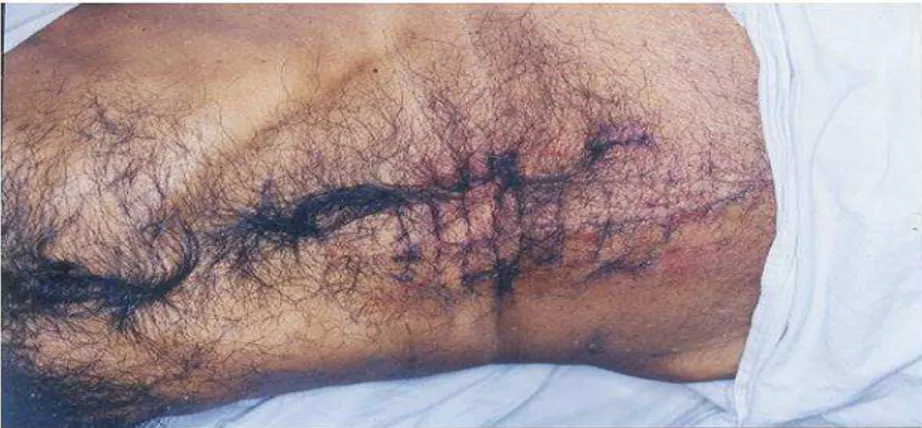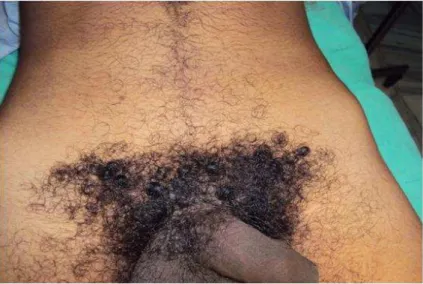Journal of Evolution of Medical and Dental Sciences/ Volume 2/ Issue 19/ May 13, 2013 Page-3327
ROLE OF PRE-OPERATIVE NO HAIR REMOVAL ON SURGICAL SITE
INFECTION.
Ashok Y Kshirsagar, Rahul K Patil, Nitin R Nangare, Sunny L Agarwal.
1. Professor, Department of General Surgery in Krishna institute of medical sciences university. 2. Resident, Department of General surgery in Krishna institute of medical sciences university.
3. Assistant Professor, Department of General Surgery in Krishna institute of medical sciences university. 4. Resident, General surgery in Krishna institute of medical sciences university.
CORRESPONDING AUTHOR: Dr. Rahul K Patil,
Krishna institute of medical sciences university, Karad, district Satara , Maharashtra
E-mail: patilrahul406@gmail.com
ABSTRACT: This prospective study evaluate the influence of pre-operative no hair removal on surgical site infection in all abdominal and groin surgeries. As there are very few articles about pre-operative no hair removal and its effect at surgical site in all types of wound. We are presenting this original article.
Prospective review of 417 patients operated in Krishna Hospital and Research Center, Karad. Between JAN-2010 to JAN-2011. The study contains clean, clean contaminated and dirty wound with two type of skin preparation. All the endogenous and exogenous factors affecting post-operative surgical site are kept constant except surgical site skin preparation like shaving by razor or no hair removal at surgical site.
In this study, we are compared role of hair removal and it impact of SSI. We had 8.21 % SSI rate by using razor shaving as skin preparation which is compared with pre-operative no hair removal. It had only 2.38% rate of SSI. The difference between standard error of two prospective is more than twice (P<0.05). So it is clear that preoperative no hair removal at surgical site is effective procedure to prevent SSI in all wound type. We are using this pre-operative no hair removal practically for all surgical intervention in our hospital.
KEY WORDS: Pre-operative no hair removal, clean wound, contaminated wound, dirty wound, surgical site infection.
INTRODUCTION: No surgeon would like to see his patient suffering from the post-operative wound infection. He would therefore like to utilize all his skill and knowledge to prevent post-operative wound infection. Surgical Site Infection (SSI) is called as ‘ A condition where the combination of the microbial numbers and virulence in the wound is significantly large to overcome the local host defense mechanism and establish progressive growth.’ All the post-operative surgical infections occurring at the operative site are now termed as SSI.
Journal of Evolution of Medical and Dental Sciences/ Volume 2/ Issue 19/ May 13, 2013 Page-3328
Contamination is a main risk factor and the majority of SSI can be attributed to the patient’s own flora.1, 2 Hence pre-operative skin preparation is one of the important methods to reduce the incidence of SSI and should include interventions that reduce the impact of endogenous flora on the incision site.3 .
There are different pre-operative skin preparations methods like,
A) No hair removal. B) Shaving by razor. C) Clipping by epilator. D) Depilatory cream.
Each method has its own merits and demerits.
In all these different methods, pre-operative no hair removal is time saving, cost effective and without risk of cut or nick trauma at surgical site.
As there are very few studies about pre-operative no hair removal and its effect on surgical site infection. Therefore this prospective study is done to know the impact of pre-operative no hair removal on SSI. The SSI not only cause economic trauma to the patient but also increases morbidity and mortality.
All cases grouped as:
Group I- Clean cases, (Hernia)
Group II- Contaminated cases (Duodenal ulcer perforation). Group III – Dirty cases (traumatic abdominal perforation).
In this prospective study it is proved that, pre-operative no-hair removal not only time saving but also prevents physical, mental and economical trauma to the patient by preventing post-operative SSI.
METHODS AND MATERIAL: This study comprised all adults between 25-50 years of age. The patient were admitted, operated and followed in wards for evidence of infection. They were also followed up on outpatient department bases for any stitch abscess or sinus for 6 months.
Routine investigations of all patients were within normal limits. No co-morbid condition was present in any of the patient included in this study. The different exogenous and endogenous factors affecting post-operative infection like age, pre-existing illness, nutritional status, pre-operative hospital stay of patient, air born contamination were kept more or less constant in all patients, except skin preparation method. All pre-operative procedures like early morning bath, painting, draping was done. Care was taken at the time of closure to prevent hair impacted in sutures or in incision. All dressings were changed on 2rd post-operative day (POD) and sutures removed on 7th POD.
If tension sutures were used (extra- peritoneally), they were removed on 9th POD. In case of contaminated and dirty cases peritoneal fluid was sent for culture and sensitivity.
Journal of Evolution of Medical and Dental Sciences/ Volume 2/ Issue 19/ May 13, 2013 Page-3329
Table-I: Surgical Classification.
Classification Explanation Example
I. Clean 1. uninfected operative wound 2. Elective operation
3. No break in sterile technique
4. If necessary drained & closed drainage
1. Hernia repair 2. Thyroid operation
II. Clean
Contaminated
1. Respiratory / Gastrointestinal / genital or urinary tract / entered under general condition
2. Minimal spillage / break in sterile technique 3. Re-operation through clean incision within 7 days
1. Appendicectomy in acute appendicitis.
2. stricturoplasty
III. ntaminated
1. Open. Fresh, accidental wounds , hrs of it 2. Major break in sterile techniques
3. gross spillage from G I tract & incision in which acute / non purulent inflammation is encountered
1. Duodenal ulcer
perforation.
2. Chronic operative wound for graft
3. Penetrating trauma less than 4 hrs
IV. Dirty / infected
1. Old traumatic wound with retained devitalized tissue & involving existing clinical infection / perforated viscera.
Perforated viscera in penetrating trauma < 4 hrs
DISCUSSION :Linton (1961) says that, ‘Despite of all attempts to make surgical procedure aseptic, it is and will probably always be impossible.1 Almost all the surgical wounds are contaminated with bacteria to some degree, but the body defense mechanism in a host kill 50-91% of organisms entering in the wound.
There are different pre-operative skin preparation methods like,
A)
No
hair
removal.
B)
Shaving
by
razor.
C)
Clipping.D) Depilatory cream.
Each method has its own merits and demerits.
Journal of Evolution of Medical and Dental Sciences/ Volume 2/ Issue 19/ May 13, 2013 Page-3330
Clipping was done by epilator machine. The rotatory movement of machine clipped out hair from hair follicles. This is Painful and costly method not useful in hairy areas. It has advantage as safe, non- traumatic, nontoxic and patient use it with brief instruction
Depilation Cream is not painful and can be used on inflamed area but it is time consuming and costly. It does no t support bacterial growth.
Pre-operative no shaving is time saving, cost effective, no trauma at surgical site and no mechanical work is required.
A surgical wound is susceptible to infection from the moment it is incised till it soundly heals. It is exposed to infection first during operation and then in wards. So using pre-operative no hair removal method, we prevent multiple trauma near surgical site, ultimately preventing contamination of surgical site by pathogenic bacteria. It is known that 6 million pathogenic staphylococci must be introduced in normal skin to produce pustule, while only 102 bacteria are sufficient to cause superficial wound infection at surgical site.7
A primarily closed surgical wound was defined by epidemiologists as infected according to either of the criteria; 8,9,11
A) If pus discharge present from the wound with or without positive culture.
B) If the responsible surgeon deemed a wound as infected based on clinical judgment.
SSI is clinically graded as:
Grade I: Redness around the surgical site. Grade II: Induration of surrounding skin.
Grade III: Stitch abscess.
Grade IV: Pus discharge. Grade V: Superficial gape. Grade VI: Wound dehiscence.3
RESULT: In this prospective study, we had compared role of hair removal in surgical site infection in
Journal of Evolution of Medical and Dental Sciences/ Volume 2/ Issue 19/ May 13, 2013 Page-3331
Table-II: Clinical Cases & Results.
Class Pre-operative no hair removal Pre-operative hair removal by razor
No. of
Cases
Cases
with SSI
Percentage No. of
Cases
Cases with SSI Percentage
Group (I) 35 - 0 48 3 6.25
Group (II) 107 2 1.87 76 6 7.89
Group (III) 78 3 3.84 83 8 9.64
Total 210 5 2.38 207 17 8.21
CONCLUSION: In this prospective study, we are compared role of hair removal and its impact of SSI in all types of wound. We had 8.21 % SSI rate by using razor shaving as skin preparation, which is compared with pre-operative no hair removal had only 2.38% rate of SSI. According to statistic the preoperative no hair removal has significant effect on SSI in all cases compare to shaving by razor as skin preparation (z > 1.967; p< 0.05).
We are using this pre-operative no hair removal practice for all surgical intervention in our hospital.
Table-III: Correlation of different studies.
No. Study Chances of infection
(No shaving) (Shaving with razor)
1 J.Alexander12 0.9 % 5.2 %
2 Seropin &Reynold 14 0.6 % 5.6 %
3 W. Alexander Sondy Aerni12 1.4 % 3.4 %
4. Cruse & Foord8 0.9 % 2.5 %
5. N. Anantakrishna(Grade II)13 Nil -
Journal of Evolution of Medical and Dental Sciences/ Volume 2/ Issue 19/ May 13, 2013 Page-3332
Table-IV –Grading of SSI and its co-relation with skin preparation. Grades of infection
No hair removal Pre-operative shaving by razor
Group I Group II Group III Total Group I Group II Group III Total
I - - - - - - - -
II - - - - 1 - 2 3
III - 1 - 1 2 2 - 4
IV - 1 1 2 - 2 2 4
V - - 2 2 - 2 3 5
VI - - - 1 1
Total - 2 3 5 3 6 8 17
REFERENCES:
1. JBI. The impact of pre-operative hair removal on SSI, Best practice. IJS, 2003; 7(2): 1-7. 2. Johnson E.M., Borwin. Rate of bacterial decolonization of skin preparation. Br. Jr. Surg, Jan
1987; 74(1): 60.
3. Alexander J. Surgical Site of Infection, Surgical clinics of North America 1985; 27:19. 4. Page C, Bohnen J. Antimicrobial prophylaxis for surgical wounds. Ann. Surg, Jan 1991; 128:
79-86
5. McInotyre F, J McCloy R. Shaving patient before operation, a dangerous myth? Ann. R. Coll, Engl, Jan 1994; 76(1):3-4.
6. Ilankovan D.G. Starg, Preoperative shaving patient and Surgeons preferences. Jr. Coll. Surg; Fab 1994, 37(6): 63-64.
7. Elek S.D. The virulence of staphylococcus pyogenes for man, A study of the problem of wound infection. Br. J. Exp. Patho. 1956; 38: 573.
8. Cruse R.J. Foord R. J., A five years prospective study of 23649 wounds Arch. Surg Aug 1973; 107: 206-210.
9. Sabiston T. The Textbook of Surgery, Wound Classification, edited by Townsend, 16th edition, Book-I, 2001;201-202.
10.National Awards of science, National research center, Division of Medical science, Ad of trauma, Ann Surg (Supp2 ),1964;160.
Journal of Evolution of Medical and Dental Sciences/ Volume 2/ Issue 19/ May 13, 2013 Page-3333
12.Alexander W, Aerni S, James P. Development of safe and effective one minute per-operative skin preparation. Arch. Surg.; Dec.1985; 120:1357-1361.
13.Anatakrishnan N., Sharma M L, Shriniwasan K. Pre-operative shaving for laparotomies-a dispersible ritua.Ind.j.surg.Jan.1995; 24: 37-38.
14.Seropian R, Reynolds B N. Wound infections after pre-operative dilatory versus razor preparation. Am. J. Surg.1971; 121: 251-254.
15.Gil Egea M.J. Verdoguer A. Surgical Wound Infection. Ann Surg. Feb.1976; 184: 758.
FIG. 1: Clinical photograph of operative procedure in dirty wound with no hair removal
Journal of Evolution of Medical and Dental Sciences/ Volume 2/ Issue 19/ May 13, 2013 Page-3334
FIG. 3: Clinical photograph of preoperative case of right sided inguinal hernia with no hair removal.

